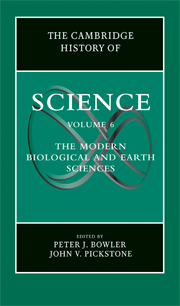Book contents
- Frontmatter
- 1 Introduction
- PART I WORKERS AND PLACES
- PART II ANALYSIS AND EXPERIMENTATION
- 10 Geology
- 11 Paleontology
- 12 Zoology
- 13 Botany
- 14 Evolution
- 15 Anatomy, Histology, and Cytology
- 16 Embryology
- 17 Microbiology
- 18 Physiology
- 19 Pathology
- PART III NEW OBJECTS AND IDEAS
- PART IV SCIENCE AND CULTURE
- Index
- References
13 - Botany
from PART II - ANALYSIS AND EXPERIMENTATION
Published online by Cambridge University Press: 28 November 2009
- Frontmatter
- 1 Introduction
- PART I WORKERS AND PLACES
- PART II ANALYSIS AND EXPERIMENTATION
- 10 Geology
- 11 Paleontology
- 12 Zoology
- 13 Botany
- 14 Evolution
- 15 Anatomy, Histology, and Cytology
- 16 Embryology
- 17 Microbiology
- 18 Physiology
- 19 Pathology
- PART III NEW OBJECTS AND IDEAS
- PART IV SCIENCE AND CULTURE
- Index
- References
Summary
Botany has played a key role in the history of the life sciences over the past two centuries. Modern taxonomic concepts and methods had their origins in studies of the plant world. Biogeography similarly began with studies of plant distribution. Darwin’s two strongest allies in England and North America, Joseph Dalton Hooker and Asa Gray, respectively, were both plant taxonomists interested in problems of geographical distribution. Darwin’s own botanical interests ranged well beyond classification and distribution to include minute studies of the fertilization of flowers and the movements of climbing plants. Meanwhile, a growing laboratory tradition, centered in Germany, made seminal contributions to cell theory, morphology, anatomy, physiology, and plant pathology, many of which aided the development of agricultural science. In the twentieth century, the new science of genetics was based on Gregor Mendel’s earlier work on cross-breeding garden plants, rediscovered by turn-of-the-century botanists and then expanded in agricultural experiment stations before becoming established in university research laboratories. Ecological science owes both its conceptual and its institutional foundations to the work of other turn-of-the-century botanists, who combined the earlier plant geography tradition with the newlaboratory approach. Later in the twentieth century, cytogenetics became established, first among botanists. Studies of plant viruses and fungal genetics led to major developments in molecular biology, many of the initial applications of biotechnology involved research on plants, and ethnobotany developed into a global enterprise under the dual influences of environmentalism on the one hand and the search for useful, and profitable, pharmaceuticals on the other.
- Type
- Chapter
- Information
- The Cambridge History of Science , pp. 225 - 242Publisher: Cambridge University PressPrint publication year: 2009



